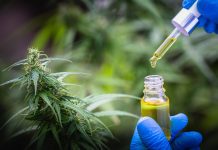
New research has unlocked the key to how cannabis creates pain relieving molecules that are 30 times stronger than Aspirin, offering huge potential as an alternative to opioids.
In 2017 the opioid crisis was classed as a public health emergency by the Canadian government and the US Department of Health and Human services. Research conducted in 2018 suggests that medical and adult-use marijuana laws have the potential to reduce opioid prescribing for Medicaid enrollees, a segment of population with disproportionately high risk for chronic pain, opioid use disorder, and opioid overdose. Cannabis itself can kill pain and according to new research would offer an alternative to opioids.
This new research has now unlocked the key to how cannabis creates important pain-relieving molecules that are 30 times more powerful than Aspirin – opening the door to creating a naturally derived pain treatment that would offer potent relief to patients without the risk of addiction that comes along with the use of other prescription painkillers.
Professor Tariq Akhtar, Department of Molecular and Cellular Biology at the University of Guelph, who worked on the study with MCB professor Steven Rothstein, said: “There’s clearly a need to develop alternatives for relief of acute and chronic pain that go beyond opioids. These molecules are non-psychoactive, and they target the inflammation at the source, making them ideal painkillers.”
Cannflavins or flavonoids
Known as ‘flavonoids’ cannflavins A and B were first identified in 1985, when research verified that they provide anti-inflammatory benefits that were nearly 30 times more effective, gram-for-gram, than acetylsalicylic acid (sold as Aspirin).
Using a combination of biochemistry and genomics, the researchers were able to determine how cannabis makes two important molecules called cannflavin A and cannflavin B.
However, further investigation into the molecules stalled for decades in part because research on cannabis was highly regulated. With cannabis now legal in Canada and genomics research greatly advanced, Akhtar and Rothstein decided to analyse cannabis to understand how cannabis sativa biosynthesises cannflavins.
Akhtar said: “Our objective was to better understand how these molecules are made, which is a relatively straightforward exercise these days. There are many sequenced genomes that are publicly available, including the genome of cannabis sativa, which can be mined for information.
“If you know what you’re looking for, one can bring genes to life, so to speak, and piece together how molecules like cannflavins A and B are assembled.”
With the genomic information at hand, they applied classical biochemistry techniques to verify which cannabis genes were required to create cannflavins A and B. Their full findings were recently published in the journal Phytochemistry.
Rothstein said: “Being able to offer a new pain relief option is exciting, and we are proud that our work has the potential to become a new tool in the pain relief arsenal.”
An alternative to opioids
The US National Institute of Health states that more than 130 people in the United States die every day after overdosing on opioids – including prescription pain killers such as fentanyl. In 2018 the number of total apparent opioid-related deaths in Canada was 4,460, making the death rate 12.0 per 100,000 population for the selected year.
Concerns have recently been raised that the UK might be following suit. Government statistics show that from 2017 to 2018 people in treatment for opiate dependence made up the largest proportion of the total numbers in treatment (53% or 141,189).
Rosanna O’Connor, Director of Alcohol, Drugs, Tobacco and Justice at Public Health England, said: “While the scale and nature of opioid prescribing does not reflect the so-called crisis in North America, the NHS needs to take action now to protect patients.”
Currently, chronic pain sufferers often need to use opioids, which work by blocking the brain’s pain receptors but carry the risk of significant side effects and addiction. Cannflavins would target pain with a different approach, by reducing inflammation, offering strong potential as an alternative to opioids.







